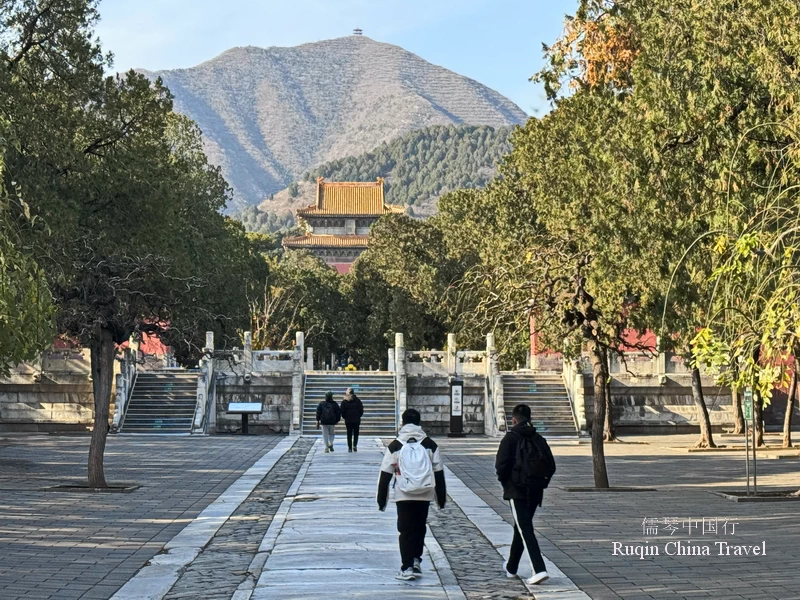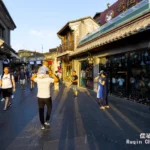While the Ming Tombs might not initially top the list of must-visit sites in Beijing, overshadowed by the allure of the Forbidden City, Summer Palace, and the Great Wall, they undoubtedly offer a unique and enriching experience.
Conveniently situated en route to prominent sections of Juyongguan Great Wall, Badaling Great Wall and Mutianyu Great Wall, and also not far from the Summer Palace, the Ming Tombs present an accessible detour. More than just a mere stopover, the Ming Tombs are a UNESCO World Heritage Site, offering an authentic glimpse into China’s profound history.
This “How to get to the Ming Tombs in Beijing” aims to unravel the mysteries of the Ming Dynasty Tombs and provide practical tips for an unforgettable visit.
1. History and Significance of the Ming Tombs
The Ming Tombs, also known as the Thirteen Ming Tombs, are located in a picturesque valley at the foot of the Tianshou Mountains. This area was chosen by the third Ming emperor, Yongle, who also built the Forbidden City.
Thirteen of the sixteen Ming emperors are buried here, making it one of the most significant imperial burial sites in China.
Ming Tombs Facts
- Construction: The tombs were built over a period of 200 years, starting in the early 15th century.
- Design: Each tomb is designed according to the status of the emperor buried there.
- Sacred Way: The tombs are connected by the Sacred Way, a path lined with statues of animals and officials.
2. How to Plan your Visit to Ming Tombs
Where Are the Ming Tombs Located?
The Ming Tombs are situated approximately 50 kilometers northwest of Beijing. They are located in Changping District, an area known for its scenic beauty and historical significance.
Best Time to Visit
The best time to visit the Ming Tombs is during spring (April to June) and autumn (September to November). During these periods, the weather is mild, and the scenery is beautiful.
Entry Fees and Hours
- Hours: The Ming Tombs are open daily from 8:00 AM to 5:00 PM.
- Fees: The entrance fee varies depending on the tomb you wish to visit. For example, the Dingling Tomb costs around 60 RMB, while the Changling Tomb costs about 45 RMB.
- For inquiries: 010-60761424, 010-60761888
Ming Tombs Ticket Prices
- Dingling Tomb: RMB 40 (Nov. 01 – Mar. 31); RMB 60 (Apr. 01 – Oct. 31)
- Changling Tomb: RMB 30 (Nov. 01 – Mar. 31); RMB 45 (Apr. 01 – Oct. 31)
- Zhaoling Tomb: RMB 20 (Nov. 01 – Mar. 31); RMB 30 (Apr. 01 – Oct. 31)
- Sacred Way: RMB 25 (Nov. 01 – Mar. 31); RMB 35 (Apr. 01 – Oct. 31)
Tickets are available until half an hour before closing time.
3. How to Get to the Ming Tombs
The Ming Tombs and Sacred Way, located about 50km north of Beijing in Changping District, are accessible by public transport.
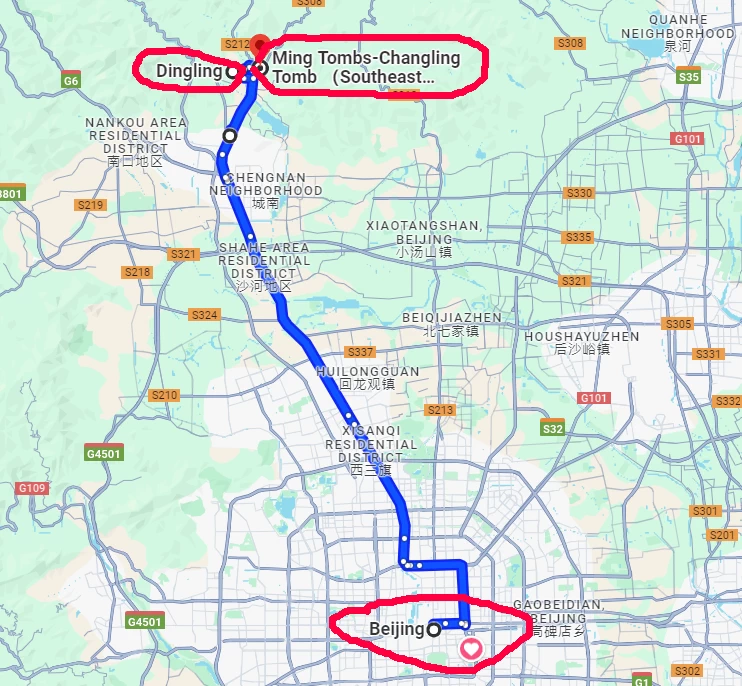
By Subway
First, take Line 13 of the Beijing Subway to Longze Station. Next, transfer to Bus 314 to reach the Ming Tombs. This route takes about 1.5 hours.
By Bus 872 ( Deshengmen – Dingling)
You can also take bus number 872 from Deshengmen Bus Station, which goes directly to Dingling Tomb (定陵)Ming Tombs. This bus ride takes approximately one hour.
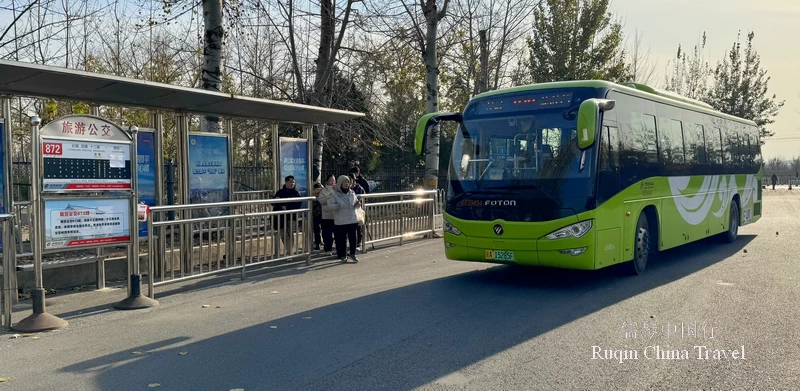
By Taxi or Ride-Hailing Services
Taxis and ride-hailing services like Didi are also good options. They offer a more direct route and take about 50 minutes, depending on traffic. However, this option is more expensive, costing around 200-300 RMB one way.
By Car
Renting a car provides flexibility and convenience. The drive from central Beijing to the Ming Tombs takes about an hour. Make sure to use a GPS or map app to navigate.
Organized Tours
Another option is to join an organized tour. Many tour companies in Beijing offer day trips to the Ming Tombs, which often include a guide and transportation. This is a stress-free way to visit and learn about the site.
4. How to Explore the 13 Ming Tombs
There are several tombs within the Ming Tombs complex, but some stand out for their historical and architectural significance.
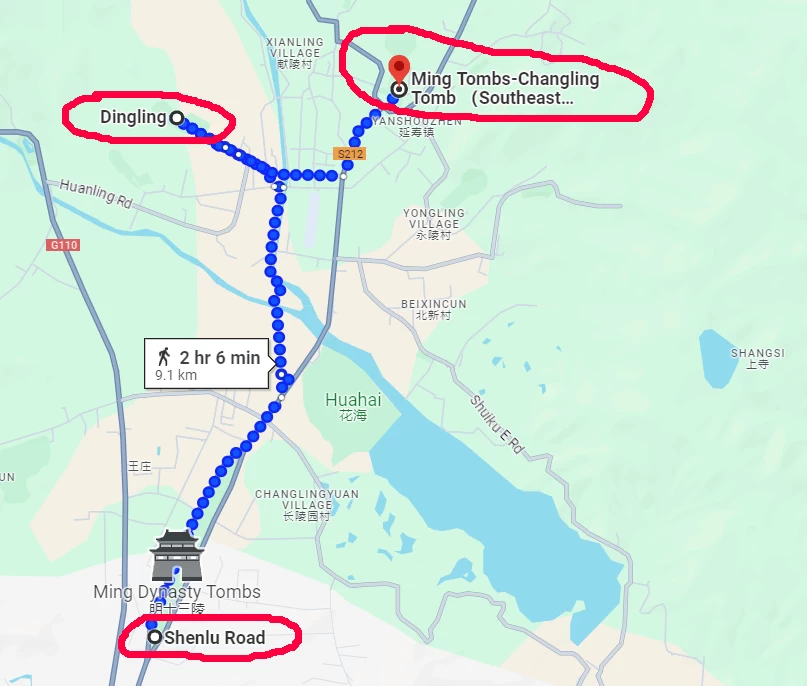
Choosing Which Tombs to Visit
Currently, only three tombs—Dingling, Changling, and Zhaoling as well as Sacred Way—are open to the public. These tombs differ in their offerings and distances from each other, influencing your choice.
Dingling Tomb: The Underground Palace
The Dingling Tomb is unique among the Ming Tombs because it has been fully excavated. It offers a rare glimpse into the underground burial practices of the Ming Dynasty.
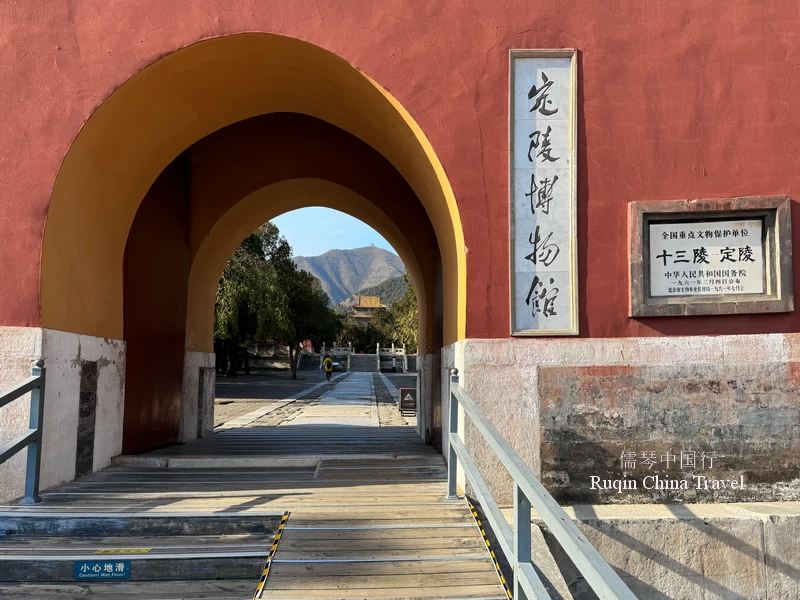
Exploring the Dingling Tomb
Underground Palace: The main attraction of Dingling is its underground palace, where Emperor Wanli and his two empresses are buried. The palace consists of five halls, including the front, middle, and rear halls, as well as the left and right annexes.
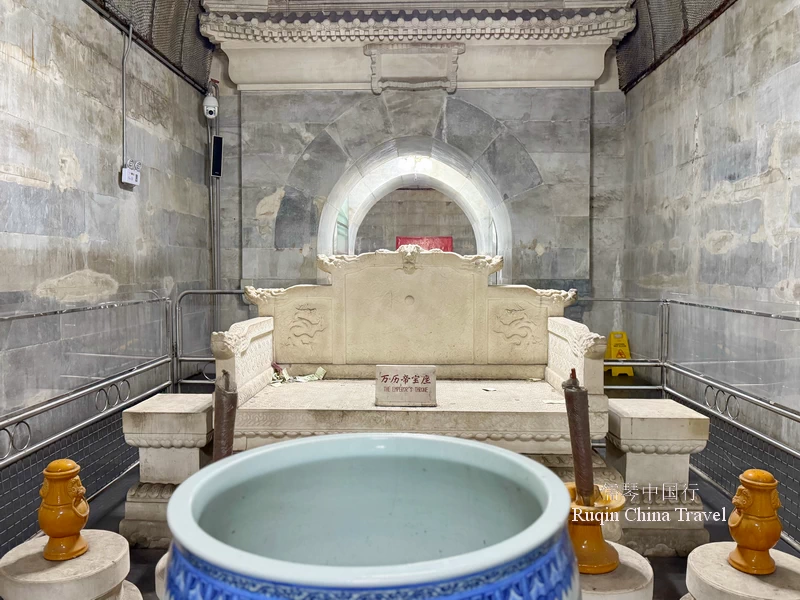
Treasures and Artifacts: The tomb contained numerous treasures, including gold, silver, jade, and porcelain items. Many of these artifacts are displayed in the museum at the site.
Throne Room: The throne room, located in the rear hall, is particularly impressive. It contains the emperor’s throne and other ceremonial objects.
Changling Tomb : The Largest Tomb
The Changling Tomb is the largest and most imposing of the Ming Tombs. It is the final resting place of Emperor Yongle, one of the most notable emperors of the Ming Dynasty.
Highlights of the Changling Tomb
- Ling’en Hall: The main hall of the Changling Tomb, known as Ling’en Hall, is a masterpiece of ancient Chinese architecture. The hall is supported by massive wooden pillars, each made from a single tree trunk.
- Stone Steles: The tomb complex includes several stone steles inscribed with the accomplishments and virtues of Emperor Yongle.
- Scenic Views: The location of the Changling Tomb offers beautiful views of the surrounding mountains and countryside, making it a serene and picturesque site.
Sacred Way
The Sacred Way, also known as the Spirit Way, is the grand avenue leading to the Ming Tombs. This path is an integral part of the tomb complex and symbolizes the emperor’s journey to the afterlife.
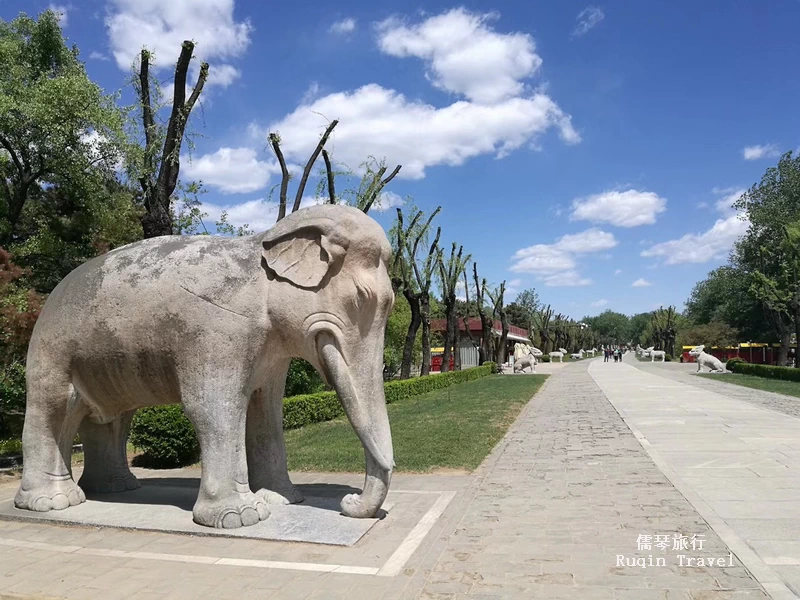
Features of the Sacred Way
The Sacred Way, or Spirit Way ( Shenlu Road), is the entry path to the complex and spans 7.3 km. However, the main attraction, requiring an entrance ticket, is a manageable 800 meters.
- Stone Statues: The Sacred Way is lined with stone statues of animals and officials. There are 12 pairs of animals, including lions, camels, and elephants, and 12 pairs of human figures, representing civil and military officials.
- Marble Archway: At the beginning of the Sacred Way stands a grand marble archway. This archway is intricately carved and signifies the entrance to the sacred area.
- Stele Pavilion: Further along the path, you’ll find the Stele Pavilion. It houses a large stone tablet inscribed with an epitaph extolling the virtues of the buried emperor.
Additional Tombs Worth Visiting
While the Dingling and Changling Tombs are the most famous, other tombs within the complex also offer unique insights and experiences.
Zhaoling Tomb
The Zhaoling Tomb is the burial site of Emperor Zhu Zaihou. It features a tranquil setting and beautiful architecture, making it a worthwhile visit.
Siling Tomb
The Siling Tomb is the tomb of Emperor Zhu Yijun. It is known for its impressive structure and the peaceful environment surrounding it.
Ticket Prices
- Dingling Tomb: RMB 40 (Nov. 01 – Mar. 31); RMB 60 (Apr. 01 – Oct. 31)
- Changling Tomb: RMB 30 (Nov. 01 – Mar. 31); RMB 45 (Apr. 01 – Oct. 31)
- Zhaoling Tomb: RMB 20 (Nov. 01 – Mar. 31); RMB 30 (Apr. 01 – Oct. 31)
- Sacred Way: RMB 25 (Nov. 01 – Mar. 31); RMB 35 (Apr. 01 – Oct. 31)
Tickets are available until half an hour before closing time.
The Ming Tombs and Sacred Way, located about 50km north of Beijing in Changping District, are accessible by public transport.
Practical Tips for Planning Your Visit
Combining with Other Attractions
Integrate the Ming Tombs visit with other Beijing attractions. Common combinations include a day trip with the Summer Palace or a section of the Great Wall (Juyongguan, Badaling, or Mutianyu).
Avoiding Crowds
The Ming Tombs are as revered by locals as the Forbidden City and Summer Palace. To avoid crowds, particularly during public holidays and weekends, plan your visit on weekdays.
Accessibility Considerations
Visitors with mobility issues should opt for Changling over Dingling, especially considering the latter’s extensive staircases.
Safety Precautions
Exercise caution when descending to Dingling’s underground palace.
Food and Refreshments
There are a few snack shops and cafes near the entrance of the Ming Tombs. However, it’s a good idea to bring your own snacks and water, especially if you plan to spend a lot of time exploring.
Souvenirs
Near the entrance and exit of the Ming Tombs, you’ll find shops selling souvenirs. These include replicas of artifacts, traditional Chinese crafts, and books about the history of the Ming Tombs.
Safety Tips
- Weather: Check the weather forecast before your visit. Bring an umbrella or raincoat if rain is expected.
- Sun Protection: In summer, wear sunscreen, a hat, and sunglasses to protect yourself from the sun.
- Emergency Contacts: Keep the contact number of your hotel and a local emergency number handy.
Frequently Asked Questions (FAQs)
Any bus connecting me to Badaling Great Wall?
After you finish exploring Dingling Tomb, you can easily reach the Badaling Great Wall by taking bus 879 directly from the parking lot of Dingling ( 定陵).
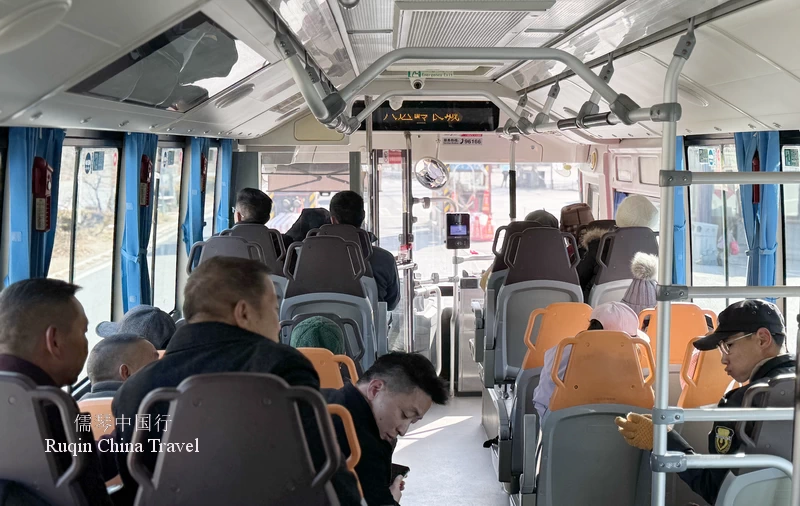
How long does it take to visit the Ming Tombs?
A visit to the Ming Tombs can take anywhere from 2 to 4 hours, depending on how many tombs you explore and your pace.
Are there guided tours available at the Ming Tombs?
Yes, guided tours are available. They can provide valuable insights into the history and significance of the tombs.
Can I visit the Ming Tombs with children?
Yes, the Ming Tombs are family-friendly. However, be prepared for a lot of walking and bring snacks and water for the kids.
What should I wear when visiting the Ming Tombs?
Wear comfortable clothing and shoes suitable for walking. In summer, wear light clothing and sun protection. In winter, dress warmly.
Is photography allowed inside the tombs?
Photography is generally allowed, but some areas may restrict the use of flash or tripods. Always check the signs.
Are there any restrictions on visiting the Ming Tombs?
Visitors are expected to respect the site. Avoid touching artifacts and follow the rules set by the authorities.
By following this “How to Get to Ming Tombs” ultimate guide, you’ll have a comprehensive understanding of how to get to the Ming Tombs in Beijing and what to expect during your visit. Enjoy exploring this remarkable historical site and immerse yourself in the rich heritage of the Ming Dynasty.
More Beijing Travel Guides
Planning your Beijing tour? Our “Beijing Travel Guide“ section offers essential advice to help you navigate the city like a pro. From transportation tips and local customs to insider recommendations for hidden gems, these travel tips will ensure you have a smooth, enjoyable, and unforgettable experience in China’s vibrant capital. Let us guide you through the best practices for exploring Beijing with confidence!

